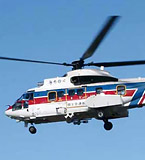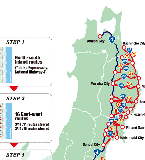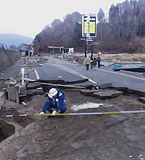The unprecedented damage was brought about by the Great East Japan Earthquake.
The bridges collapsed. The roads were covered with full of debris. Towns and communities along the Pacific coast of Tohoku were isolated.
Immediately after the earthquake, the Tohoku Regional Bureau secured the routes for rescue and relief operations, extended support to the affected areas, and undertook temporary restoration works. Here is the story of what happened and what we did.
Outline of the Great East Japan Earthquake
1. Occurrence of the Earthquake and Approaching Tsunami

A magnitude 9.0 earthquake occurred on March 11, 2011 at 14:46 JST. An emergency rescue helicopter “Michinoku” was scrambled from Sendai Airport 37 minutes after the occurrence of the earthquake. A few minutes later, Sendai Airport was engulfed by tsunami.
Live coverage of damage and tsunami by the rescue helicopter Michinoku provided a great deal of important information to determine our response to the disaster.
2. Road Clearance

From the day following the earthquake, “road clearance” works (Operation “Teeth of a Comb”) were started. The road clearance works secure a route just wide enough for a car to get through.
In the midst of fear of aftershocks and another tsunami, the site managers of construction companies and the road administrators considered the road clearance works to be their mission. They wanted to do anything to help out the affected area. They determined to undertake the road clearance works, and dedicated themselves to the works.
The road clearance works were completed much earlier than the original schedule, thanks to the collaboration with the JSDF, the police, and both prefectural and municipal organizations concerned, which took care of the bodies found during the clearance works.
3. Support to the Disaster-Affected Areas

Liaisons (on-site information coordinators for disaster response) were dispatched to the affected areas on the day of the disaster. They were required to understand the needs of the municipal leaders in details. They had been engaged in procurement and coordination activities of any kind of materials, as important and trusted partners of the municipal leaders.
“I will leave everything to your discretion. Saving people’s lives is the highest priority. Consider you a representative of the nation, and do whatever it takes.” Entrusted by the
Minister of Land, Infrastructure, Transport and Tourism, the liaisons procured everything ranging from a temporary housing substitute for city office, fuels, etc. to sanitary items and coffins for the affected areas. The mission was well beyond their routine work.
4. Temporary Restoration

The Bureau stated to investigate the extent of damage in the affected area from the second day following the earthquake.
The Bureau promptly made a construction contract, following the “emergency limited tender” procedure authorized only in case of emergency such as natural disasters, and started restoration in cooperation with local construction companies, etc.
Construction of a temporary bridge for the Kesen Ohashi Bridge on Route 45 in Rikuzentakata of Iwate Prefecture was completed in 61 days, much faster than a standard construction period of 120 days.
Emergency restoration works of the levees of inland rivers, such as the severely affected levee of the Eaigawa River in Osaki, Miyagi Prefecture, etc., was also completed before the flood season.
